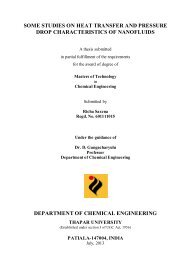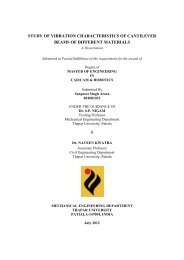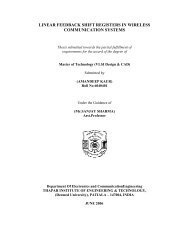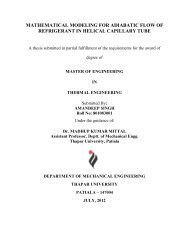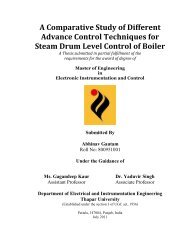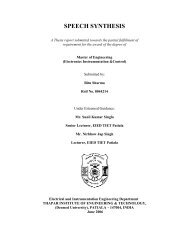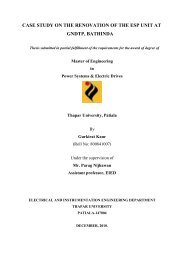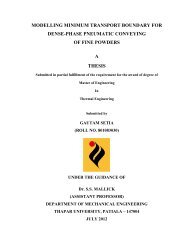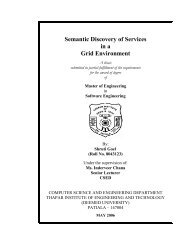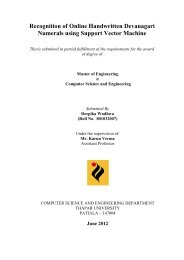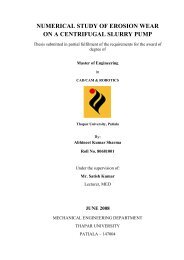from indigenous fermented foods and human gut ... - Thapar University
from indigenous fermented foods and human gut ... - Thapar University
from indigenous fermented foods and human gut ... - Thapar University
You also want an ePaper? Increase the reach of your titles
YUMPU automatically turns print PDFs into web optimized ePapers that Google loves.
138<br />
Chapter V Discussion<br />
for 90 min <strong>and</strong> at 121 o C for 15 min. Sparo et al. (2006) also reported a stable enterocin MR<br />
99 <strong>from</strong> E. faecium. Partially purified bacteriocin appeared stable when pH was adjusted<br />
<strong>from</strong> 4-12. These results are supported by various research findings (Moreno et al., 2003;<br />
Sparo et al., 2006; Abriouel et al., 2006; Shin et al., 2008; Ghrairi et al., 2008).<br />
Antibacterial activity of the partially purified bacteriocin was completely destroyed<br />
upon treatment with proteolytic enzyme. Bacteriocin activities were not affected by lipase,<br />
lysozyme, <strong>and</strong> catalase <strong>and</strong> the results were in accordance with the findings of Park et al.<br />
2003; Abriouel et al. 2006; Cocolin et al. 2007 <strong>and</strong> Ghrairi et al. 2008. They identified <strong>and</strong><br />
characterized enterocin produced by E. faecium <strong>and</strong> reported their inactivation by proteinase<br />
K, trypsin, α-chymotrypsin <strong>and</strong> papain, but not by lysozyme, lipase, catalase or β-<br />
glucosidase. Among the detergents, Sodium dodecyl sulphate (SDS), Tween 80 <strong>and</strong> Tritone<br />
X-100 stimulated bacteriocin production, which was strongly inhibited by EDTA <strong>and</strong> urea.<br />
Similar results were observed by Ivanova et al. (2000) <strong>and</strong> Ogunbanwo et al. (2003). But,<br />
stimulatory effect of Sodium dodecyl sulphate (SDS), Tween 80 <strong>and</strong> Tritone X-100 on<br />
bacteriocin in playing that the detergents act as co-factors, which are required to increase the<br />
bacteriocin production. A bacteriolytic effect was noted against Listeria monocytogenes for<br />
the bacteriocin produced by L. casei LAM-1.<br />
The molecular weight of bacteriocins produced by L. casei LAM-1 was ~2.5 kDa <strong>and</strong><br />
a single inhibition zone was observed <strong>from</strong> the partially purified bacteriocin preparations<br />
<strong>from</strong> the strains of L. casei LAM-1, suggesting the production of only one potent bacteriocin.<br />
Moreno et al. (2003) also reported single inhibitory zone for all bacteriocin after<br />
electrophoresis followed by a bioassay. The molecular mass of the bacteriocin was between<br />
2.5 <strong>and</strong> 6.2 kDa as described by Ying et al. 2011. The bacteriocin was stable under different<br />
storage temperatures (4, 28 <strong>and</strong> 37 o C as tested up to 6 months. The molecular weight of the



